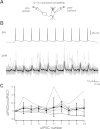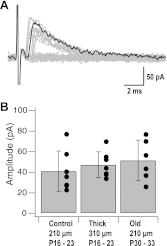Intrinsic and synaptic properties of vertical cells of the mouse dorsal cochlear nucleus
- PMID: 22572947
- PMCID: PMC3424078
- DOI: 10.1152/jn.00778.2011
Intrinsic and synaptic properties of vertical cells of the mouse dorsal cochlear nucleus
Abstract
Multiple classes of inhibitory interneurons shape the activity of principal neurons of the dorsal cochlear nucleus (DCN), a primary target of auditory nerve fibers in the mammalian brain stem. Feedforward inhibition mediated by glycinergic vertical cells (also termed tuberculoventral or corn cells) is thought to contribute importantly to the sound-evoked response properties of principal neurons, but the cellular and synaptic properties that determine how vertical cells function are unclear. We used transgenic mice in which glycinergic neurons express green fluorescent protein (GFP) to target vertical cells for whole cell patch-clamp recordings in acute slices of DCN. We found that vertical cells express diverse intrinsic spiking properties and could fire action potentials at high, sustained spiking rates. Using paired recordings, we directly examined synapses made by vertical cells onto fusiform cells, a primary DCN principal cell type. Vertical cell synapses produced unexpectedly small-amplitude unitary currents in fusiform cells, and additional experiments indicated that multiple vertical cells must be simultaneously active to inhibit fusiform cell spike output. Paired recordings also revealed that a major source of inhibition to vertical cells comes from other vertical cells.
Figures









References
-
- Alibardi L. Cytological characteristics of commissural and tuberculo-ventral neurons in the rat dorsal cochlear nucleus. Hear Res 216–217: 73–80, 2006 - PubMed
-
- Blackstad TW, Osen KK, Mugnaini E. Pyramidal neurones of the dorsal cochlear nucleus: a Golgi and computer reconstruction study in cat. Neuroscience 13: 827–854, 1984 - PubMed
Publication types
MeSH terms
Grants and funding
LinkOut - more resources
Full Text Sources
Miscellaneous

